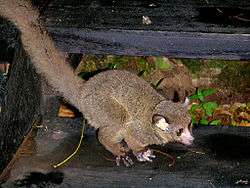Greater galago
| Greater galagos[1] | |
|---|---|
 | |
| Brown greater galago (Otolemur crassicaudatus) | |
| Scientific classification | |
| Kingdom: | Animalia |
| Phylum: | Chordata |
| Class: | Mammalia |
| Order: | Primates |
| Suborder: | Strepsirrhini |
| Family: | Galagidae |
| Genus: | Otolemur Coquerel, 1859 |
| Type species | |
| Otolemur agyisymbanus | |
| Species | |
|
Otolemur crassicaudatus | |
The greater galagos or thick-tailed bushbabies are everyday names for three species of strepsirrhine primates. They are classified in the genus Otolemur in the family Galagidae.
- Genus Otolemur
- Brown greater galago, Otolemur crassicaudatus
- Otolemur crassicaudatus crassicaudatus
- Otolemur crassicaudatus kirkii
- Silvery greater galago, Otolemur monteiri
- Otolemur monteiri monteiri
- Otolemur monteiri argentatus
- Northern greater galago, Otolemur garnettii
- Otolemur garnettii garnettii
- Otolemur garnettii lasiotis
- Otolemur garnettii kikuyuensis
- Otolemur garnettii panganiensis
- Brown greater galago, Otolemur crassicaudatus
Historical classification and species discovery
The diversity of galago species has historically been grossly underestimated. In 1931, only 5 species were recognized, 4 in the genus Galago and 1 in Euoticus, and only one species that would later be placed in the genus Otolemur.[2] In 1979, the genus Otolemur was separated from Galago.[3] By 1986, eleven species were recognized with revamped systemic classification including Otolemur crassicaudatus and Otolemur garnettii.[4] Additionally, O. crassidautus and O. monteiri were recognized as separate species instead of O. monteiri as a nested subspecies.[4] By 2001, 23 species were recognized. Classification by vocalization has particularly become prevalent and helpful as a tool in understanding of these species. All Otolemur species exhibit trailing advertising calls.[2]
Distribution and habitat
The species is found in coastal regions of East Africa ranging from the Juba River in Somalia, through Mozambique and Tanzania down to the northern parts of South Africa and as far west as Angola. For the most part they live in woods but also in wooded grasslands and even city parks.
References
- ↑ Groves, C.P. (2005). "Genus Otolemur". In Wilson, D.E.; Reeder, D.M. Mammal Species of the World: A Taxonomic and Geographic Reference (3rd ed.). Baltimore: Johns Hopkins University Press. pp. 126–127. ISBN 0-801-88221-4. OCLC 62265494.
- 1 2 Grubb, Peter; Butynski TM; Oates JF; Bearder SK; Disotell TR; Groves CP; Struhsaker TT (December 2003). "Assessment of the Diversity of African Primates". Internal Journal of Primatology. 24 (6): 1301–1357.
- ↑ Olson, T. R. (1979). Studies on Aspects of the Morphology and Systematics of the Genus Otolemur. London: Phd thesis, University of London.
- 1 2 Olson, T. R. (1986). "Species Diversity and Zoogeography in the Galagidae". Primate Rep. 214: 213.
External links
| Wikimedia Commons has media related to Otolemur. |
| Wikispecies has information related to Greater galago |